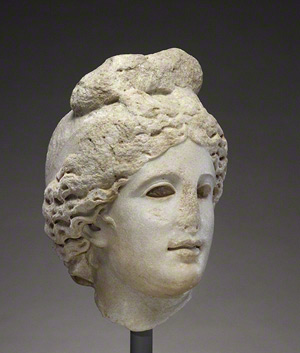Objects and Fragments

Head of Apollo, Roman, A.D. 175–200. Marble, 16 9/16 in. high. The J. Paul Getty Museum, 58.AA.2
The plaster casts of classical sculptures studied by later artists were most often reproductions of partial figures and fragments, such as this Roman head of the god Apollo, modeled after a Greek original. The modern artists in this exhibition would have been well acquainted with such classical heads, and often included images of them in their work.
Pablo Picasso's teenage student drawings show his early awareness that he was copying not merely sculpted bodies but also ancient remnants that had become modern objects.
Pablo Picasso's teenage student drawings show his early awareness that he was copying not merely sculpted bodies but also ancient remnants that had become modern objects.
- AUDIO: Learn more about this image of Apollo.
Update Required
To play the media you will need to either update your browser to a recent version or update your Flash plugin.
Zeus in the Studio
Pablo Picasso's still lifes of the mid-1920s often feature a bust or head. In Studio with Plaster Head, a 1925 painting of his studio in southern France, a plaster-cast bearded head, probably representing the god Zeus or a Roman emperor, presides over a gathering of objects that include an open book, a twig in leaf, a square, and two plaster-cast arms and hands, one gripping a rod.The contrived, theatrical character of the arrangement in Studio with Plaster Head is accentuated by the miniature stage-set-like townscape behind—in fact, the toy theater of Picasso's son Paulo. Ancient sculpture lives on in fragments of plaster copies, integrated into an intimate modern context.
- AUDIO: Hear how the head in Studio with Plaster Head has a Cubist sensibility.
Update Required
To play the media you will need to either update your browser to a recent version or update your Flash plugin.
A Dreamlike Antiquity
For Giorgio de Chirico as well as Picasso, plaster-cast heads were fragmentary objects as much as autonomous works of art.His 1913 picture The Transformed Dream plays with different kinds of distance: the distance in time of antiquity, represented in a plaster-cast head of Zeus; the distance in space of the places where pineapples and bananas were harvested for the European market; and the distance to be crossed by the steam locomotive. All these elements come together in a dreamlike scene with stretched perspectives. Antiquity—presented as dead, immobile matter—lies at one extreme of the space-time spectrum.
- AUDIO: Why did de Chirico juxtapose Zeus with exotic fruits in The Transformed Dream?
Update Required
To play the media you will need to either update your browser to a recent version or update your Flash plugin.
Classical Vase as Modern Object
In the late 1920s, Fernand Léger depicted the classical vase as a modern object. The columnar body of the modern Madonna in his 1927 painting Woman Holding a Vase (Definitive State) appears less alive than the bright red object she embraces. The vessel's classical profile and "anatomical" sections—its neck, belly, and foot—line up with the woman's body, making the object an extension or completion of the figure.Léger refined this painting over several states between 1924 and 1927; parallel to the classicism of the 1920s, there was a glorification of craft among the European avant-garde.
Artwork images were removed from this page after the close of the exhibition, when the Getty's rights to use them expired.
Publication
Modern Antiquity: Picasso, de Chirico, Léger, Picabia
By Christopher Green and Jens M. Daehner
By Christopher Green and Jens M. Daehner

